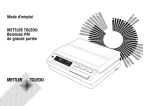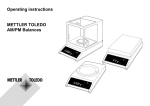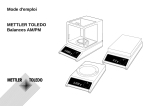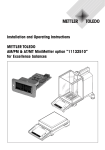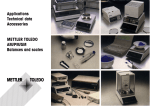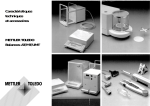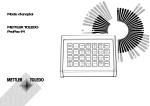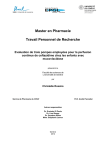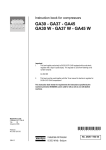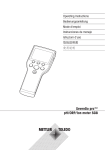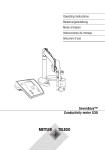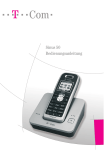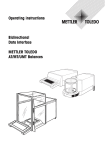Download Mettler Toledo LJ16 Operating instructions
Transcript
Installation and Operating Instructions METTLER TOLEDO Infrared Dryers LJ16 LP16 °C MO DE % EN TE 0.. . -10 0% R 10 0.. . 0% AT R 0.. O . -99 9% AT R 10 O 0 99 ... 9% ST AR T ST OP Leerseite Contents Page 2 1. Cautionary notes 2. General 2.1 The infrared dryer 4 3. Mounting 3.1 3.2 3.3 Preparing for mounting the LJ16 Preparing for mounting the LP16 Mounting the LJ16 and LP16 5 6 7 4. Key pad assignment 4.1 4.2 Keys with direct function Keys with subsequent entry 10 11 5. Operation 5.1 5.2 5.3 5.4 Operation of the LJ16 Operation of the LP16 Performing a drying operation with the LJ16 or LP16 Attachment of accessories 13 15 18 20 6. What if ...? 21 7. Maintenance 7.1 7.2 Changing the fuses Cleaning 25 26 8. Appendix 8.1 8.2 8.3 Accessories Technical data Admissible ambient conditions 27 28 29 1 2 1. Cautionary notes Your infrared dryer corresponds to state of the art technology and meets the requirements regarding instrument safety. This notwithstanding, improper handling can lead to hazards for personnel and tangibles. Please note the following instructions for safe and dependable operation: • The infrared dryer is used to determine moisture in samples. Please use the instrument solely for this purpose. Any other application can endanger personnel and lead to damage to the instrument or other tangibles. • The infrared dryer may be operated only by qualified personnel who are familiar with the properties of the samples used and the handling of the instrument. • Use only indoors in closed rooms. • The infrared dryer may not be used in a hazardous environment and must be operated only under the ambient conditions specified in these instructions. • The infrared dryer operates with heat! • Ensure sufficient free space around the instrument to avoid heat accumulation and overheating (approx. 1 m free space above the instrument). Warning: hot surface • Do not place any material on top, underneath or in the immediate vicinity of the instrument while the latter is connected to the mains, as the area surrounding the drying unit will heat up. • Exercise caution when removing the sample: The sample itself, the draft shield and any sample pan used can still be very hot. The cooling time for the sample pan is approx. 1 minute. • Your infrared dryer is supplied with a 3-core power cable with an equipment grounding conductor. Only extension cables which comply with the standards and also have an equipment grounding conductor may be used. Deliberate disconnection of the equipment grounding conductor is strictly forbidden! Certain samples require special care! Certain types of samples may possibly represent a hazard to personnel or tangibles through: Fire or explosion • Flammable or explosive substances • Substances containing solvent • Substances which evolve flammable or explosive gases or vapors when dried. When working with such samples, ensure a drying temperature which is low enough to prevent ignition or explosion and wear protective goggles. If uncertainty exists regarding the flammability of a sample, always work with small amounts of sample (max. 1 gram). In cases of doubt, conduct a careful risk analysis. Poisoning, burning • Substances which contain highly volatile toxic or corrosive components. Such substances may be dried only in a fume cupboard. Corrosion Substances which evolve corrosive vapors on warming (e.g. acids). For such substances we advise working with small amounts of sample as the vapors can condense on colder housing parts and cause corrosion. Please note that the user is always responsible and liable for damage caused by the use of the above-mentioned types of samples! • Make no modifications or alterations to your instrument and use only original spare parts and accessories supplied by METTLER TOLEDO. • Your infrared dryer is a rugged precision instrument - nevertheless, you should handle it carefully and it will thank you with many years of trouble-free operation. • Please heed all instructions and information in these operating instructions. Keep the instructions in a safe place where they are always available should uncertainties arise. If you lose the instructions, please contact your METTLER TOLEDO dealer to obtain a replacement copy. 3 4 2. General 2.1 The infrared dryer The infrared dryer is used to determine water or moisture content. This type of analysis is employed primarily in the following fields: • Determination of storage life and quality • Quality monitoring and control of intermediate products • Monitoring of and compliance with statutory regulations °C MO The principal application area of the infrared dryer is the food and chemical industries. DE % EN TE 0.. . -100 R 10 0.. . 0% % AT RO 0.. . -999 % AT RO 10 0.. 99 . 9% ST AR T ST OP LJ16 The LJ16 Infrared Dryer is a simple-to-operate, compact instrument with integrated balance for routine work in the lab and production. LP16 The LP16 is a high-quality instrument for the lab. The LP16 can be operated with the following METTLER TOLEDO balances: • PM100, PM200, PM300, PM400, PM480, PM600 3. Mounting 3.1 Preparing the balance for mounting the LJ16 1 3 2 4 Checking the set voltage Before first-time operation of the dryer, the associated balance must be checked for correct setting of the operating voltage. A label showing the set voltage is affixed above the power socket in the factory. If this specification does not match the power supply voltage or if the label is missing, the setting of the voltage selector inside the balance must be checked and altered if necessary. Resetting the operating voltage Warning • First ensure that the instrument is disconnected from the power supply. If the power cable (1) is attached, the interior of the balance is live even if the display is blank! • When the operating voltage is reset, the microfuse must be changed. (Section 7.1) Resetting • Remove weighing pan, unscrew screw (2) and carefully lift off top housing (3). Reset voltage selector (4) with a screwdriver. • Carefully remount top housing and insert and tighten screw (2). Selecting the location The correct location should be selected according to the following criteria: • Stable, vibration-free position as horizontal as possible • No drafts 5 6 3.2 Preparing the balance for mounting the LP16 Removing the weighing pan • Take off weighing pan (1) and pan support (2). 1 2 0.00 Installing the compensation weight on the LP16 If the LP16 is mounted on a PM600, PM2000, PM4000 or PM4800, the compensation weight in the draft shield must be changed. • Unscrew 3 screws (5); disassemble draft shield. • Take out compensation weight (7) built in as standard. • Install compensation weight. • Reassemble draft shield. Marking (6) and cutout (8) must be aligned. 9 Resetting the operating voltage Warning • First ensure that the instrument is disconnected from the power supply. If the power cable (1) is attached, the interior of the balance is live even if the display is blank! • When the operating voltage is reset, the microfuse must be changed. (Section 7.1) 4 5 6 7 8 Resetting • Remove weighing pan, unscrew screw (2) and carefully lift off top housing (3). Reset voltage selector (4) with a screwdriver. • Carefully remount top housing and insert and tighten screw (2). Selecting the location The correct location should be selected according to the following criteria: • Stable, vibration-free position as horizontal as possible • No drafts 3.3 Mounting the LJ16 and LP16 drying unit 1 2 3 Note Before mounting, the preparatory measures must have been carried out. LJ16, see section 3.1. LP16, see section 3.2. • Lift up drying cover (1). • Take foam cushioning and plastic sheet out of draft shield (2). Remove draft shield with packaging. • Affix label with warning regarding heat development so that it is clearly visible. Setting the operating voltage • Set voltage selector (3) at rear of dryer so that the voltage matches the local power supply voltage: 115 V (range 93 V ... 132 V) 230 V (range 187 V ... 264 V) Mounting the dryer • Mount dryer carefully on the balance as shown in the illustration opposite. Center hole (6) on conical spigot of balance. • Turn dryer clockwise until the stop. The dryer is now mounted on the balance by means of the bayonet fixing. 6 7 8 Inserting the spacer bolt Prepare spacer bolt (1): The spacer bolt must have a length of approx. 66 mm. If the bolt is shorter: • Hold knurled nut (2) and loosen the lower half (3) by turning counterclockwise. • When the bolt is the required length, screw knurled nut (2) to lower half (3). • Mount spacer bolt (1) with taper leading on conical spigot of the balance. • Mount draft shield (5) on the three centering pegs (6). Ensure that spacer bolt (1) slides onto centering peg (7). • Insert pan support (8) in draft shield (5) and press downward gently. 1 8 4 3 2 5 7 1 6 13 16 12 11 10 9 15 14 Attaching the cables • Attach the short connection cable (9) enclosed with the accessories to socket (10) of the balance and to socket (11) of the dryer. • Connect drying unit and balance to the power supply. If a LC-P45 Printer or a GA37 Digital/Analog Converter is attached: • Attach connection cable (14) from the accessories of the printer or digital/analog converter to socket (15) of the dryer and to the appropriate socket of the LC-P45 or GA37. • Turn on power switch (16). • Switch on balance using the tare bar. The flashing lamp of the START key at the front of the dryer signals operational readiness. ATRO 0..... 999% ATRO 100.. .... 999% STAR STOP T Function check • Tap pan support (7) with your hand and check whether the balance display reacts. • Check whether the display shows a constant value when the pan support is at rest. If this is not the case, the length of spacer bolt (12) must be corrected and the seating of draft shield (5) checked, see also section 6, “What if...?” 7 Optimum configuration (the balance) For optimum functioning of the infrared dryer, the balance must be configured as followed: LJ16: Stability detector ASd-2Integration time Int-2Setting the configuration, see section 5.1. LP16: Stability detector ASd-2Pause 0 Vibration adapter Weighing process adapter Setting the configuration, see operating instructions of the PM balance used. 5 12 Leveling the balance • Turn screw feet (1) so that the air bubble is in the middle of level (2). 2 Note After every location change, the balance should be releveled. 1 1 9 10 4. Keypad assignment 4.1 Keys with direct function 100... 0% 0... -100 % Calculation mode keys Calculation of the dry weight In this calculation mode, the dry weight of the sample is calculated in percent (referred to the wet weight = 100 %). At the end of the drying time, the dry weight (100 % ... 0 %) is available. The drying progress can be followed on the display. Calculation of the moisture content In this calculation mode, the moisture content of the sample is calculated in percent (referred to the wet weight = 100 %). At the end of the drying time, the moisture content (0 % ... -100 %) is available. During drying, the progress of the operation is displayed continuously. ATRO 100... 999 % Calculation of the wet weight In this calculation mode, the wet weight of the sample is calculated in percent (referred to the dry weight = 100 %). At the end of drying, the wet weight (ATRO value) is available in percent referred to the dry weight of 100 % (100 % ... 999 %). No percentage display is possible during the drying operation. ATRO 0... -999 % Calculation of the moisture content ATRO In this calculation mode, the moisture content of the sample is calculated in percent (referred to the dry weight = 100 %). At the end of the drying time, the moisture content (ATRO value) is available in percent referred to the dry weight of 100 % (0 % ... -999 %). No percentage display is possible during the drying operation. Switch key This key allows selection between weight and percentage display during the drying operation. Note regarding calculation mode ATRO value: If the dry weight (key ATRO 0 ... -999 % or ATRO 100 ... 999 %) is used as a basis for the calculation, a percentage display is not possible until the drying operation has ended. % START START key This key is used to start the drying operation: • Lamp flashes 1 instrument in operational readiness. • Lamp lit up 1 drying operation in progress. STOP STOP key With this key, each initiated drying operation can be ended (aborted). The final value in the display is marked with (*) and kept until the drying cover is opened or taring performed. If a printer is attached, the final result is printed out at the same time. 4.2 Keys with subsequent entry of a value °C Drying temperature key This key is used – before the start of a drying operation – to call up the stored drying temperature (50 °C ... 160 °C) to the display and release it for change. Drying time key This key is used – before the start of a drying operation – to call up the stored drying time (0 ... 240 minutes) to the display and release it for change. Note for operation of the LJ16 When the time key is pressed, the value range 0, Auto ... 240 is available for selection. If -Auto- is selected, the automatic switch-off criterion of 2 mg/30 s is active. 11 12 Print interval key This key is used – before the start of a drying operation – to call up the stored print interval time of 0 ... 9.9 minutes to the display and release it for change. MODE MODE key (LP16 only) This key is used – before the start of a drying operation – to select the desired MODE (operating mode). MODE MODE d/10 s MODE d/30 s MODE d/120 s LJ16: see manual switching off or switching off with time switch switching off with switch-off criterion, weight loss d adjustable Adjustment keys to change the recalled values This key can be used to increment the displayed value. Single steps are possible by pressing briefly. This key can be used to decrease the displayed value. Single steps are possible by tapping. ENTER ENTER key This key accepts and stores an entry (temperature, drying time, print interval time, MODE). Note All set values and operating parameters are stored in a fail-safe manner. 5. Operation 5.1 Operation of the LJ16 Controls (1) Control bar of the balance (tare bar) (2) Keypad of the dryer °C MO DE % EN 0.. . -100 TE R 10 0.. . 0% % AT RO 0.. . -999 % AT RO 10 0.. 99 . 9% STA RT ST OP 1 Switching display on/off • Press control bar (1) briefly ; all display segments light up for a few seconds. • The display then shows 0.000 g. • Raise control bar briefly; the display blanks out. Taring 2 • Place aluminum sample pan on pan support. • Press control bar (1) briefly; the display changes to 0.000 g. 0.0009 Calibrating Before work is performed for the first time with the LJ16 dryer, the balance should be calibrated. To achieve a correct calibration, it is advisable to attach the instrument to the power supply 30 minutes before calibrating. Calibration is necessary only if the absolute sample weight is of importance. • Press control bar (1) until -CAL- appears, then release; display changes to - - - - - - and then to calibration weight (flashes). • Load requested calibration weight (e.g. 100 g); display changes to - - - - - -, then 0.000 g flashes. • Remove calibration weight; display shows - - - - - - and then changes to 0.000 g. The instrument is now calibrated. 13 14 Changing weighing speed or reproducibility The LJ16 can be adapted to the ambient conditions. For this, the appropriate setting should be selected for the integration time and the stability detector. Setting stability detector Weighing speed ASd -1ASd -2ASd -3ASd -4- Reproducibility very fast good relatively slow very good Stability detector • Press control bar until -ASd- appears, then release. • Press control bar briefly; the display changes to the next setting. • At the desired setting, wait until the display returns to the operating mode. Integration time Possible settings Int-1- With very stable, vibration-free surroundings Int-2- Normal setting Int-3- With unfavorable ambient conditions Performing the settings • Press control bar until -Int- appears in the display, then release. • Press control bar briefly; the display changes to the next setting. • At the desired setting, wait until the balance returns to the operating mode. Optimum settings, see section 3.3. 5.2 Operation of the LP16 Controls (1) Control bar of the balance (tare bar) (2) Keypad of the dryer °C MO DE % EN 0.. . -100 TE R 10 0.. . 0% % AT RO 0.. . -999 % AT RO 10 0.. 99 . 9% STA RT ST OP 1 2 0.0009 Switching display on/off • Press control bar briefly; all display segments light up for a few seconds. • The display then shows 0.000 g. • Raise control bar briefly; the display blanks out. Taring • Mount aluminum sample pan on the weighing pan. • Press control bar briefly; the display changes to 0.000 g. Calibrating Before work is performed for the first time with the LP16 dryer, the balance should be calibrated. To achieve a correct calibration, it is advisable to attach the instrument to the power supply 30 minutes before calibrating. Calibration is necessary only if the absolute sample weight is of importance. The calibration procedure is described in the operating instructions of the PM balance used. 15 16 Changing weighing speed or reproducibility The LP16 can be adapted to the ambient conditions. For this, the appropriate setting should be selected for the stability detector, the weighing process adapter and the vibration adapter. Setting stability detector Weighing speed ASd -1ASd -2ASd -3ASd -4- Reproducibility very fast good relatively slow very good Stability detector Performing the settings • Press control bar until -ASd- appears in the display, then release. • Press control bar briefly; the display changes to the next setting. • At the desired setting, wait until the display returns to the operating mode. Setting the weighing process adapter Performing the settings Fine dispensing Normal setting, setting for the LP16 Absolute weighing Setting options appears, then release. • Press control bar briefly until • Press control bar briefly; the display changes to the next setting. • At , wait until the display returns to the operating mode. Setting the vibration adapter Performing the settings With very stable, vibration-free surroundings Normal setting With unfavorable ambient conditions Setting options • Press control bar until appears, then release. • Press control bar briefly; the display changes to the next setting. • At the desired setting, wait until the display returns to the operating mode. Optimum settings, see section 3.3. 5.2.1 Sample weight Automatic switch-off criterion The LP16 and LJ16 have an automatic switch-off criterion. The adjacent curve shows the typical weight profile of a sample during a drying operation. The automatic switch-off criterion offers the user the possibility of terminating drying automatically when the weight loss per time interval is less than a preset value. Wet Example: Weight loss < 2 mg/30 sec. Dry Time LP16: Variable, freely selectable, automatic switch-off criterion (1 ... 99 mg/10 sec, 1 ... 99 mg/30 sec, 1 ... 99 mg/120 sec). LJ16: fixed, automatic switch-off criterion (2 mg/30 sec). 17 18 5.3 Performing a drying operation with the LJ16 or LP16 Switching off with manual stop 0... 100... -100 % 0% ATRO 0... -999 % ATRO 100... 999 % Select calculation mode Press key of the desired calculation mode. Switching off with the time switch 0... 100... -100 % 0% ATRO 0... -999 % ATRO 100... 999 % Set drying time 0 Press the drying time key. Set time 0 (infinitely long drying). Press ENTER key. ENTER °C ENTER Select calculation mode Press key of the desired calculation mode. 0... 100... -100 % 0% ATRO 0... -999 % ATRO 100... 999 % Set drying time Press the drying time key. Set time. Press ENTER key. ENTER Set drying temperature Press drying temperature key. Set drying temperature. Press ENTER key. Switching off as soon as the preset weight loss per time interval is reached ENTER ENTER Set drying temperature Press drying temperature key. Set drying temperature. Press ENTER key. ENTER Set print interval (if printer attached) Press print interval key. Set interval time. Press ENTER key. °C °C ENTER ENTER Set print interval (if printer attached) Press print interval key. Set interval time. Press ENTER key. ENTER Select calculation mode Press key of the desired calculation mode. Set switch-off criterion LP16: Press MODE key until the desired abort criterion is displayed (LED flashes). Press ENTER key. LJ16: see section 4.2 Set drying temperature Press drying temperature key. Set drying temperature. Press ENTER key. Set print interval (if printer attached) Press print interval key. Set interval time. Press ENTER key. Switching off with manual stop START % STOP Switching off with the time switch Switching off as soon as a preset weight loss per time interval is reached Load sample • Open drying cover. • Mount aluminum pan on the pan support. • Tare. • Distribute sample evenly. • Close dryer. Load sample • Open drying cover. • Mount aluminum pan on the pan support. • Tare. • Distribute sample evenly. • Close dryer. Load sample • Open drying cover. • Mount aluminum pan on the pan support. • Tare. • Distribute sample evenly. • Close dryer. Start Start Press START key Start Press START key Press START key Switching between % and g Press switch key. Not possible during operating mode ATRO value. Stop Press STOP key. Warning Aluminum pan with sample is very hot. START % STOP Switching between % and g Press switch key. Not possible during calculation mode ATRO value. Stop After elapse of the set drying time, the dryer switches off automatically. Warning Aluminum pan with sample is very hot. 19 START % STOP Switching between % and g Press switch key. Not possible during calculation mode ATRO value. Stop When the set weight loss per time interval is reached, the dryer switches off automatically. Warning Aluminum pan with sample is very hot. 20 5.4 Attachment of accessories Attachment to LJ16, LP16 LC-P45 Top unit Printer Attachment of the LC-P45 Printer for recording results numerically Printout with time,date and sample number Balance GA37 Top unit D/A Converter Balance Attachment of the GA37 Digital/Analog Converter for graphical representation of the drying profile Set print interval to 0.1 minutes for this. Line recorder Attachment to LP16 Top unit LC-P45 Printer Attachment of the DataPac-M for sample identification with keypad entry Attachment of the GM54 Output Module for signalization of the end of drying Balance On completion of drying, the contact of the GM54 closes and remains closed for 1 second. DataPac Keypad GM54 Output Module Attachment to PC Top unit Printer cable Balance Software: Windows (Microsoft) BalanceLink (METTLER TOLEDO) Excel (Microsoft) Drying data can be automatically read into the Excel spreadsheet program via the unidirectional RS232 data interface using the BalanceLink software. Note: Set print interval to 0.1 minutes. 6. What if ...? Error/Display Possible cause Rectification After switching on, only the bottom segments of the display light up • Spacer bolt too short • Draft shield not mounted correctly • Compensation weight not installed in draft shield • Lengthen spacer bolt • Mount draft shield correctly • Install compensation weight Unstable value in the display • Spacer bolt too long • Draft shield not mounted properly • Shorten spacer bolt • Mount draft shield correctly After addition of the sample, only the top segments of the display light up • Weighing range exceeded • Spacer bolt too long • Remove sample • shorten Display “OFF” • Power outage • Repeat drying operation. The parameter entries are not lost through a power outage. No LED light up on the dryer • • • • • • • • • • Only the LED START flashes • Balance switched off • Connection cable from balance to dryer loose or not plugged in • Switch on balance • Plug in connection cable properly After switching on, the configuration is wrong • The configuration has been changed • Reenter operating parameters Instrument not switched on No power supply voltage Power cable not plugged in Voltage selector not set properly Microfuse blown 21 Switch on dryer Check power supply Plug in power cable Set voltage selector correctly Check functioning of the microfuses and replace fuses if need be 22 Error/Display Possible cause Rectification Lamp of the MODE key flashes (LP16 only) • Entry not closed with ENTER • Close entry with ENTER Drying unit does not heat • Flat connector from top part to balance not plugged in • Infrared radiators faulty • Plug in connector properly • Inform METTLER TOLEDO customer service • Close entry with ENTER The parameters to be changed can not be called up • Previous entry not closed with ENTER No entry possible • A drying operation has been performed beforehand • Connection cable balance - dryer missing • Tare or open drying cover When the START key is pressed, “Err 0” lights up (no start possible) • Previous entry not closed with ENTER • Close entry with ENTER When the START key is pressed, “Err 1” lights up (no start possible) • Sample has been tared • Remove sample, tare and add sample again • Select larger sample • Weight of sample too low (less than 100 digits) When the START key is pressed, “Err 2” lights up (no start possible) • Drying cover opened • Close cover “Err 3” • Percent value larger than display capacity • In the calculation of an ATRO value, the weight value is 0 • Perform new drying • Perform new drying Error/Display Possible cause Rectification Drying operation does not start and no error message in the display • Connection dryer - balance interrupted • A drying operation has been performed beforehand • Set up correct connection • Open drying cover No switching between weight and percentage display possible • Drying operation has not been started • The calculation mode ATRO value has been selected for the drying operation • Start drying • Percentage display does not appear until after end of drying operation Termination of the drying operation • Control bar of the balance or the STOP key on the dryer has been pressed • Weight value has become negative • The set abort criterion is too large, drying is aborted since the effective weight loss of the sample per time interval is less than the abort criterion • Perform drying again • Balance not yet stable • On stability, the drying operation starts automatically When the START key is pressed, the dashed wait line - - - - - - appears. • Sample evaporates even before the start of drying • Stability not reached up to timeout since unstable ambient conditions 23 • Perform drying again • Enter lower value and repeat drying • Set vibration adapter to unstable surroundings (LP16) • Increase integration time (LJ16) 24 Error/Display Possible cause Rectification Drying operation is not aborted until after 3'10", 3'30" or 5' although the sample no longer loses weight • Minimum drying time 3'10"/3'30"/5', depending on the setting of the abort criterion • Perform new setting or use time-controlled switching off The message ERROR appears in the display • Admissible temperature range exceeded • Disconnect power connector and plug in again • If error message remains, inform METTLER TOLEDO service The reproducibility of the results is unsatisfactory • The sample material is inhomogeneous in regard to moisture • The sample material is hygroscopic or contains highly volatile substances that evaporate even before the start of the infrared drying • Film formation at sample surface • Drying is incomplete since it has been prematurely terminated • Small amount of sample • Low moisture content • Increase amount of sample • Calculate mean values • Change sample preparation • Use blotting paper to increase surface area • Increase amount • Prolong time 7. Maintenance 7.1 Changing the fuses Changing “3.15 A slow-blow” fuse • Disconnect power cable of the dryer! • Lever out holder (1) of the microfuse using a screwdriver. • Change 3.15 A slow-blow microfuse (spare in holder). • Plug in connector cable. 1 Changing “200 mA slow-blow” or “100 mA slow-blow” fuse • Disconnect power cable of the dryer! • Take out holder (2) particular microfuse with a screwdriver turning it to the left. • Replace “200 mA slow-blow” or “100 mA slow-blow” microfuse (spare in the accessories). • Push in holder (2) using a screwdriver and then secure by turning to right (up to stop). • Plug in power cable. 2 3 4 Replacing microfuses of the balance The spare fuse is in the fuse holder (4). Fuse ratings: 115 V = 125 mA slow-blow 230 V = 63 mA slow-blow • Disconnect power cable (3). • Take out fuse holder (4) using a screwdriver. • Remove blown fuse and insert new one. • Replace fuse holder. Plug in power cable. 25 26 7.2 Cleaning NITRO The draft shield should occasionally be freed from dust and dirt. The reflector must be kept clean. A cloth and some soapy water suffice for external cleaning. Never use powerful solvents. The above are the only cleaning operations needed for the dryer. 8. Appendix 8.1 Accessories Description Order No. Aluminum pan, set of 80 Pan support Spacer bolt Compensation weight No. 2 Draft shield Power cable Connection cable Microfuse 3.15 mA slow-blow (in holder) Microfuse 200 mA slow-blow (set of 3) Microfuse 100 mA slow-blow (set of 3) Warning sticker 13865 600210 13942 13794 600203 depending on country 13969 54286 20181 16511 13909 Supplied on request: Chrome steel pan (set of 3) Hand switch associated adapter LP16 thermometer set Temperature calibration kit Data Pac-M Keypad GA37 Digital/Analog Converter GA44 Printer GM54 Output Module Software BalanceLink V 2.0 or higher 13954 42500 33872 13701 214240 27 28 8.2 Technical data Power supply admissible range 115 V admissible range 230 V Frequency Power consumption LP16 (e.g. with PM480) 115 V/230 V (selectable) 93 V ... 132 V 187 V ... 264 V 50 Hz ... 60 Hz max. 470 VA LJ16 115 V/230 V (selectable) 93 V ... 132 V 187 V ... 264 V 50 Hz ... 60 Hz max. 470 VA Temperature (range) Graduation Time switch (range) Calculation modes 50 °C ... 160 °C 5 °C 0 ... 240 min 4 methods 50 °C ... 160 °C 5 °C 0 ... 240 min 4 methods Percent calculation (range for ATRO) Resolution (sample >10 g) Resolution (sample <10 g) Repeatability (sample = 1 g) 1) Repeatability (sample = 10 g) 1) Minimum sample weight Maximum sample weight Resolution of balance 0 ... 999 % 0.01 % 0.1 % 0.2 % 0.02 % 0.1 g 400 g 1 mg 0 ... 999 % 0.01 % 0.1 % 0.3 % 0.03 % 0.1 g 300 g 1 mg 1 ) To achieve this repeatability, the instrument must have been switched on for at least 2 hours. (applies to a typical drying time of approx. 10 min.). Dimensions (W x D x H) Weight incl. balance Interface (for LC-P45 Printer or computer connection; BalanceLink) Drying method Automatic abort criterion Application brochure Active display Identification of the sample with DataPac-M Graphical representation (GA37) DeltaTrac® Balance usable separately LP16 (e.g. with PM480) 195 x 330 x 260 mm approx. 7 kg LJ16 195 x 330 x 260 mm approx. 7 kg RS232 and CL Infrared drying ≥ 1mg / 120 sec ... 99mg / 10 sec x x x x x x RS232 and CL Infrared drying 2mg / 30 sec x x – – – – 8.3 Admissible ambient conditions Temperature Storage temperature max. relative humidity Height max. Overvoltage category Pollution degree + 10 °C ... + 40 °C - 25 °C ... + 70 °C 80 % 2000 m NN II 2 29 To protect your METTLER TOLEDO product’s future: METTLER TOLEDO Service assures the quality, measuring accuracy and preservation of value of all METTLER TOLEDO products for years to come. Please send for full details about our attractive terms of service. Thank you. Subject to technical changes and to the availability of the accessories supplied with the instruments. *P704719* © Mettler-Toledo GmbH 1999 704719D Printed in Switzerland 9902/2.12 Mettler-Toledo GmbH, Laboratory & Weighing Technologies, CH-8606 Greifensee, Switzerland Phone +41-1-944 22 11, Fax +41-1-944 30 60, Internet: http://www.mt.com
































